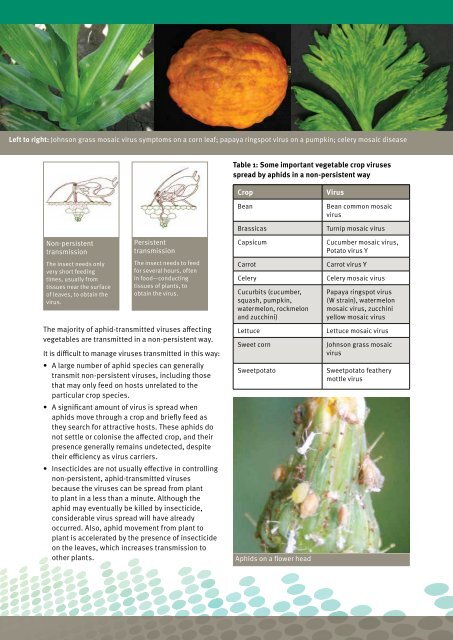Aphid-transmitted viruses in vegetable crops
Aphid-transmitted viruses in vegetable crops
Aphid-transmitted viruses in vegetable crops
Create successful ePaper yourself
Turn your PDF publications into a flip-book with our unique Google optimized e-Paper software.
Left to right: Johnson grass mosaic virus symptoms on a corn leaf; papaya r<strong>in</strong>gspot virus on a pumpk<strong>in</strong>; celery mosaic disease<br />
Table 1: Some important <strong>vegetable</strong> crop <strong>viruses</strong><br />
spread by aphids <strong>in</strong> a non-persistent way<br />
Non-persistent<br />
transmission<br />
The <strong>in</strong>sect needs only<br />
very short feed<strong>in</strong>g<br />
times, usually from<br />
tissues near the surface<br />
of leaves, to obta<strong>in</strong> the<br />
virus.<br />
Persistent<br />
transmission<br />
The <strong>in</strong>sect needs to feed<br />
for several hours, often<br />
<strong>in</strong> food—conduct<strong>in</strong>g<br />
tissues of plants, to<br />
obta<strong>in</strong> the virus.<br />
The majority of aphid-<strong>transmitted</strong> <strong>viruses</strong> affect<strong>in</strong>g<br />
<strong>vegetable</strong>s are <strong>transmitted</strong> <strong>in</strong> a non-persistent way.<br />
It is difficult to manage <strong>viruses</strong> <strong>transmitted</strong> <strong>in</strong> this way:<br />
• A large number of aphid species can generally<br />
transmit non-persistent <strong>viruses</strong>, <strong>in</strong>clud<strong>in</strong>g those<br />
that may only feed on hosts unrelated to the<br />
particular crop species.<br />
• A significant amount of virus is spread when<br />
aphids move through a crop and briefly feed as<br />
they search for attractive hosts. These aphids do<br />
not settle or colonise the affected crop, and their<br />
presence generally rema<strong>in</strong>s undetected, despite<br />
their efficiency as virus carriers.<br />
• Insecticides are not usually effective <strong>in</strong> controll<strong>in</strong>g<br />
non-persistent, aphid-<strong>transmitted</strong> <strong>viruses</strong><br />
because the <strong>viruses</strong> can be spread from plant<br />
to plant <strong>in</strong> a less than a m<strong>in</strong>ute. Although the<br />
aphid may eventually be killed by <strong>in</strong>secticide,<br />
considerable virus spread will have already<br />
occurred. Also, aphid movement from plant to<br />
plant is accelerated by the presence of <strong>in</strong>secticide<br />
on the leaves, which <strong>in</strong>creases transmission to<br />
other plants.<br />
Crop<br />
Bean<br />
Brassicas<br />
Capsicum<br />
Carrot<br />
Celery<br />
Cucurbits (cucumber,<br />
squash, pumpk<strong>in</strong>,<br />
watermelon, rockmelon<br />
and zucch<strong>in</strong>i)<br />
Lettuce<br />
Sweet corn<br />
Sweetpotato<br />
<strong>Aphid</strong>s on a flower head<br />
Virus<br />
Bean common mosaic<br />
virus<br />
Turnip mosaic virus<br />
Cucumber mosaic virus,<br />
Potato virus Y<br />
Carrot virus Y<br />
Celery mosaic virus<br />
Papaya r<strong>in</strong>gspot virus<br />
(W stra<strong>in</strong>), watermelon<br />
mosaic virus, zucch<strong>in</strong>i<br />
yellow mosaic virus<br />
Lettuce mosaic virus<br />
Johnson grass mosaic<br />
virus<br />
Sweetpotato feathery<br />
mottle virus

















